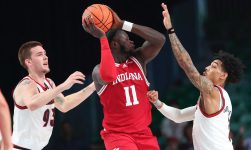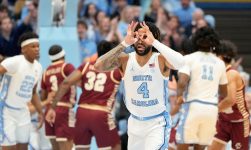CBS Sports college basketball insiders Gary Parrish and Matt Norlander spent a month surveying 100-plus Division I men’s basketball coaches for our annual Candid Coaches series. They polled across the sport’s landscape: some of the biggest names in college basketball, but also small-school assistants in low-major leagues. Coaches agreed to share unfiltered opinions in exchange for anonymity. We asked 10 questions and are posting the results over a three-week span.
The 2024-25 NCAA calendar year is the final year that college athletes who played during the 2020-21 COVID-affected season can take advantage of a special additional tour of eligibility.
Prior to COVID, with rare exception, NCAA athletes had five years to complete four seasons of eligibility. The bonus COVID year has given athletes five years of eligibility, since the 2020-21 season was rife with coronavirus-prompted pauses, game cancellations and more. High-profile college basketball players who are utilizing a fifth year in ’24-25 include All-American candidates Mark Sears (Alabama), Johni Broome (Auburn), Hunter Dickinson (Kansas), RJ Davis (UNC) and Ryan Kalkbrenner (Creighton).
Over the past few years, two aftereffects of this COVID rule have significantly impacted college basketball. The good: The sport has been older on average over the past four seasons than it had been for decades prior to that. In general, the older the players, the better the basketball. The maybe-not-so-good: hyper-transfer activity has become a staple of college hoops, making the sport more difficult for the average fan to familiarize themselves with than ever before.
The portal is here to stay, of course; expect a thousand-plus players to hop in and explore their options annually moving forward. But what if there was a way to entice a bit more roster retention? There is a way, you know.
That in mind, we asked …
Should players get a fifth year of eligibility if they stay at one school?
Quotes that stood out
Those who voted yes
“This is the first I have heard of this concept, and I think it is a decent idea. Obviously, the large number of players transferring every year is something that most people invested in college basketball believe is a net negative. Therefore, anything that lowers the number of players transferring on a yearly basis is something I would welcome.” “Yes, they should, and I want mine. The market incentivizes transferring, which is why it’s rampant. Our game needs help in this area.””Yes, however, it’s contingent upon the player getting a degree from that institution within four years. We need to incentivize staying at one place and encourage families to recognize the advantages of vetting their choices on the front end. A fifth year for Baylor Scheierman and Kevin McCullar actually aided their draft potential. Also, having fifth-year talent like Max Abmas and Hunter Dickinson add to the marketability of the game.”
“I think this is the one place, and also the easiest, for us to stay tied to education and incentivize academic achievement. My proposal would be this simple: If a kid graduates by the end of his/her eighth semester, then he/she earns an extra year of eligibility. So ‘no’ to having to stay explicitly at one school to earn fifth year, but ‘yes’ to earning fifth year if he/she has graduated in four.””Promoting loyalty and consistency will help the student-athletes graduate easier, could improve NIL money — at least at mid-major or lower — better networking bases with alumni, which will help them after basketball.”
“My knee-jerk reaction was to say no because I think we all are excited to be done with these COVID years. But I do think the ‘fifth year with the same program’ idea could help mid-majors hang on to their guys more. Getting their master’s paid for might be more enticing than getting 50-75K in NIL.””I like that idea, think it’s an amazing incentive for a player. Would it change things? Probably not very much, so don’t think it will work. And does that kid have to use that fifth year at the school they graduated from? Like it in theory more than practicality.””I think this is a very good incentive for stability on both the player and the team side. I would argue that they could use the fifth year at any school they want to after they’ve completed their four years at the one school. They put in their due, and it will give low/mid players the opportunity to make the jump to big-time basketball and money, and it would give a high-major player the chance to find a better situation or a fresh start, if they want it.”
Those who voted no
“A guy should be able to transfer and still play as much as someone who didn’t transfer. Don’t think there should be a penalty for transferring or an incentive for not.”
“No. Graduate and get on with your life.””Players should be allowed five years to play four to keep the balance of high school student-athletes having an opportunity.”
“I don’t understand why we are talking about giving out a fifth year. Once we get past this COVID craziness, we need to get back to five-to-play-four.”
“I am old-school in that four years should be it unless you have an injury or are redshirted. I feel if you do that, you are hurting the youth of the game because of limitation of scholarships.””Players should not be penalized for transferring, as there are many legitimate reasons for doing so. I feel as though players should be able to go and choose as they will. Now, having contractual years on NIL contracts is a different topic.” “This sounds good in theory, but this would just be another way for the schools with the most NIL money to reap the benefits of the rules. I only think high-major schools could offer enough money to incentivize players to stay for a fifth year. Don’t forget these guys would be required to be in classes and maintain their academic eligibility.””I think days of holding kids to staying at one school are over. If we are going to give fifth year, give it to everyone.”
The takeaway
Before I get into why this is such a ripe topic for discussion in college sports right now, let’s address how this survey question has two interpretations.
Option A) The fifth year is ONLY allowable if a player remains at ONE institution their entire career. You only get the fifth year if you never transfer.
Option B) A bonus year of eligibility is permitted to ANY school, but the player can ONLY use that bonus year if they have graduated after attending only one school for up to four years.
Coaches I polled voted based on their own interpretations. The heart of this question is whether or not a coach agrees with the concept of awarding an extra year ONLY after staying at one school for undergrad. In talking to a variety of sources, Option B is much more likely to get traction, should it ever become seriously considered. (Which it should. More on that in just a second.)
“The market incentivizes transferring, which is why it’s rampant. Our game needs help in this area.”
AAC coach
Many coaches I surveyed who hadn’t previously heard of this concept were as intrigued by this question as any other on our list this year. Reality is, it’s a topic that has been pushed in recent months behind the scenes by none other than John Calipari. And though Calipari isn’t the only one championing the idea, he is the most well-known coach who is pushing for the possibility to allow a fifth year of eligibility — but only if a player earns an undergraduate degree after attending only one school.
The concept has also been discussed multiple times by the National Association of Basketball Coaches and will be further vetted by the NABC later this year.
This was our closest vote of any 2024 Candid Coaches survey question. I agree with 53% who voted yes. There is nothing wrong with players seeking to better their situations (and dealing with the potential fallout that comes with multiple transfers as an undergrad), but it’s undeniable that college basketball’s marketability is negatively impacted by having so many players switch schools, many of them multiple times, while most of the ultra-talented ones only wind up staying for one season before leaping for their NBA dreams.
This proposal encourages roster retention while allowing for the occasional player to take advantage of an extra year. It helps keep college basketball a little bit older, which is a good thing, especially when it comes to helping the mid-major programs that by and large feel a heavier brunt of the portal than their power-conference counterparts. Important context that must be taken into consideration here. Many players — the overwhelming majority, in fact — would not take advantage of this if offered. The temptation to transfer will win out over maybe eventually staying five years in college. But I have a feeling there would be just enough who would do this, particularly at the mid-major level, that would make the rule worth bringing into existence.
If enacted, the transfer cycle each year would have a fascinating “free agent” class of 21- and 22-year-olds who, under Option B, would become all the more valued. After all, they’d be the only transfers on the market with four years of college experience. What’s more, the NCAA recently passed legislation permitting college basketball programs to scholarship up to 15 players. Most schools will not do this for a variety of reasons, but in bumping the number from 13 to 15, you are creating a buffer to boost the sport by rewarding players who remain loyal, graduate on time and want to continue their college experience to maximal ends. With 15 scholarship spots, you can do this while not hurting the incoming population of high school recruits who annually fill up more than a thousand scholarships across D-I basketball.
Coming out of the COVID era, this is a fresh idea that puts a priority on education, advocates for student-athletes and, most of all, improves college basketball. By allowing a fifth year for those who meet the criteria, the sport can be a little bit older, which means it can be a little bit better.
Previously in Candid Coaches …






